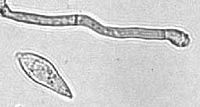
Three-dimensional visualization of mitochondria in conidia of Pyricularia oryzae using green fluorescent protein (GFP) fused with citrate synthase (CitA)
Sign Up to like & getrecommendations! Published in 2020 at "Journal of General Plant Pathology"
DOI: 10.1007/s10327-020-00928-0
Abstract: The mitochondrion is the target organelle for QoI (quinone outside inhibitor) antifungal drugs, but mitochondrial behavior in Pyricularia oryzae remains unclear. Conidial mitochondria in fungal isolate transformed with citrate synthase (CitA)-GFP fusion gene, were observed… read more here.
Keywords: citrate synthase; mitochondria conidia; synthase cita; pyricularia oryzae ... See more keywords

Mitochondrial dynamics in Pyricularia oryzae during conidiation monitored by fluorescent microscopy
Sign Up to like & getrecommendations! Published in 2021 at "Journal of General Plant Pathology"
DOI: 10.1007/s10327-021-01037-2
Abstract: Pyricularia oryzae , which causes blast disease in rice, is a serious fungal pathogen of many cereal crops. Mitochondria have been a promising target to develop antifungal agents. We observed the movement and morphology of… read more here.
Keywords: dynamics pyricularia; pyricularia oryzae; microscopy; conidiation ... See more keywords

Management of rice blast (Pyricularia oryzae): implications of alternative hosts
Sign Up to like & getrecommendations! Published in 2021 at "European Journal of Plant Pathology"
DOI: 10.1007/s10658-021-02326-4
Abstract: Rice blast (Pyricularia oryzae) has become a serious disease on commercial rice (Oryza sativa) crops in northern Australia and is present there on wild rice (O. australiensis). Characterisation of the host range of P. oryzae… read more here.
Keywords: blast; rice; management; rice blast ... See more keywords

The chitin deacetylase PoCda7 is involved in the pathogenicity of Pyricularia oryzae.
Sign Up to like & getrecommendations! Published in 2021 at "Microbiological research"
DOI: 10.1016/j.micres.2021.126749
Abstract: The fungal cell wall plays an essential role in maintaining cellular integrity and facing complex and changing environmental conditions. Whether a fungus successfully invades a host depends on whether it evades the plant's innate immune… read more here.
Keywords: chitin deacetylase; pocda7; cell wall; chitin ... See more keywords

Regulatory Mechanism of Mycotoxin Tenuazonic Acid Production in Pyricularia oryzae.
Sign Up to like & getrecommendations! Published in 2017 at "ACS chemical biology"
DOI: 10.1021/acschembio.7b00353
Abstract: Tenuazonic acid (TeA) is a mycotoxin produced by the rice blast fungus Pyricularia oryzae and some plant pathogenic fungi. We previously demonstrated that TeA is biosynthesized in P. oryzae by TeA synthetase 1 (TAS1) and… read more here.
Keywords: tenuazonic acid; pyricularia oryzae; production; tea production ... See more keywords

Diversity and Distribution of Rice Blast (Pyricularia oryzae Cavara) Races in Vietnam.
Sign Up to like & getrecommendations! Published in 2019 at "Plant disease"
DOI: 10.1094/pdis-05-19-1008-re
Abstract: A total of 239 isolates of blast (Pyricularia oryzae Cavara) collected from northern and central Vietnam showed a wide variation in pathogenicity based on the reaction patterns to 25 differential varieties (DVs) harboring 23 resistance… read more here.
Keywords: pik; oryzae cavara; blast pyricularia; piz ... See more keywords

Pathogenicity of Isolates of the Rice Blast Pathogen (Pyricularia oryzae) from Indonesia.
Sign Up to like & getrecommendations! Published in 2020 at "Plant disease"
DOI: 10.1094/pdis-05-20-0949-re
Abstract: A total of 201 isolates of Pyricularia oryzae (the causal agent of rice blast) were collected from three rice ecosystems (upland, lowland, and swampy) in five regions of Indonesia (West Java, Lampung, South Sumatra, Kalimantan,… read more here.
Keywords: pathogenicity; pik; pyricularia oryzae; rice blast ... See more keywords

First Report of Pyricularia oryzae Causing Blast on Palm Grass in China.
Sign Up to like & getrecommendations! Published in 2022 at "Plant disease"
DOI: 10.1094/pdis-05-22-1077-pdn
Abstract: Palm grass (Setaria palmifolia) has been used as an ornamental plant and vegetable crop (Wu, 2009; Plarre, 1995). In June 2019, 2-10 mm severe leaf lesions with gray centers and brown-yellow edges were observed on… read more here.
Keywords: palm grass; grass; pyricularia oryzae; blast ... See more keywords

Silicon Alleviates Changes in the Source-Sink Relationship of Wheat Plants Infected by Pyricularia oryzae.
Sign Up to like & getrecommendations! Published in 2019 at "Phytopathology"
DOI: 10.1094/phyto-11-18-0428-r
Abstract: Blast, caused by Pyricularia oryzae, has become a devastating disease on wheat in several countries worldwide. Growers need alternative methods for blast management, and silicon (Si) stands out for its potential to decrease the intensity… read more here.
Keywords: pyricularia oryzae; wheat plants; flag leaves; leaves spikes ... See more keywords

Male fertility in Pyricularia oryzae: Microconidia are spermatia
Sign Up to like & getrecommendations! Published in 2022 at "Environmental Microbiology"
DOI: 10.1111/1462-2920.16226
Abstract: Abstract Sexual reproduction in Ascomycetes is well described in several model organisms such as Neurospora crassa or Podospora anserina. Deciphering the biological process of sexual reproduction (from the recognition between compatible partners to the formation… read more here.
Keywords: microconidia; male fertility; pyricularia oryzae; spermatia ... See more keywords

Picolinic acid spray stimulates the antioxidative metabolism and minimizes impairments on photosynthesis on wheat leaves infected by Pyricularia oryzae.
Sign Up to like & getrecommendations! Published in 2019 at "Physiologia plantarum"
DOI: 10.1111/ppl.12917
Abstract: Fungal pathogens produce toxins that are important for their pathogenesis and/or aggressiveness towards their hosts. Picolinic acid (PA), a non-host selective toxin, causes lesions on rice leaves resembling those originated from Pyricularia oryzae infection. Considering… read more here.
Keywords: spray; metabolism; photosynthesis; antioxidative metabolism ... See more keywords